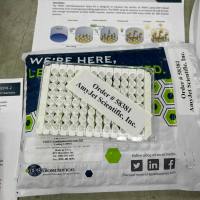The studies of hybrid resistance (HR) to murine bone marrow cell (BMC) grafts have been helpful in elucidating the biology and genetics of natural killer (NK) cell mediated recognition of incompatible cells (
1 ). The discovery and claim for HR is contrary to the laws of transplantation genetics. Thus rejection of H2
b/d BMC by H2
b/d F1 hybrid mice did not fit with the known codominant inheritance of major histocompatibility complex (MHC) class I and II antigens. The development of the “missing self” hypothesis seems to explain most instances of HR; thus NK cells express a Ly49 family of receptors for “self” class I antigens. The Ly49 molecules and perhaps other receptors on NK cells receive “negative signals” from class I antigens (
2 ). F1 H2
b/d NK cells have two subpopulations of NK cells, those with receptors for H2
d and those with receptors for H2
b . Transplantation of H2
b/b BMC into these H2
b/d hosts results in rejection because the subset of NK cells with receptors for H2
d class I antigens fails to recognize H2
b/b BMC as self. The results of BMC allografts also depend on a donor cell type, called the facilitating cell (FC) (
3 ). FCs were detected when it was observed that BMCs depleted of T cells were hypersusceptible to rejection by irradiated mice; e.g., BMCs from mice with severe combined immunodeficiency (SCID) are strongly rejected (
4 ). Addition of sources of T cells, e.g., thymocytes, can restore the FC and render SCID BMC grafts more like “normal” parental strain BMC grafts. Therefore two donortype cells, stem cells and FCs, are potential targets for rejection by host effector cells. In most instances, the effector cells are NK cells, but sometimes CD8
+ T cells reject either LNC or BMC allografts (
5 ). We present here our methods for studying murine BMC transplants in mice. Similar studies can also be done with grafts of spleen or lymph node cell (LNC) grafts that undergo graft-vs-host responses (
6 ). Table 1 lists the outcome of BMC grafts in various donor-host combinations, almost always based on H2 type of donor. The NK gene complex on chromosome 6 has one or more genes that confer the relative ability of mice to reject H2 allogeneic or parental-strain BMC grafts (
7 ).
|
BMC
|
|
Donor
|
Host strains
|
|
|
|
H2 a
|
“good responders”
|
“poor responders”
|
H2
|
|
b/b
|
B10.D2, NZB, B10.D2 x DBA/2
|
BALB/c, DBA/2
|
d/d
|
|
|
B10.BR, C57BR, B10.BR x C3H
|
C3H, CBA
|
k/k
|
|
|
B10.A, B10.A x A
|
A
|
a/a
|
|
|
B10 x DBA/2, B10 x B10.D2, 129 x C3H
|
BALB/cxBALB.B
|
d/b
|
|
d/d
|
B6, B10, B10 x 129
|
129, BALB.B,D1.LP
|
b/b
|
|
|
B10.BR
|
C3H, CBA
|
k/k
|
|
|
NZB x NZW (H2d/z )
|
B6 x DBA/2b
|
b/d
|
|
|
|
BALB/c x BALB.B
|
d/b
|
|
k/k
|
NZB
|
B10.D2, DBA/2, BALB/c
|
d/d
|
|
|
None
|
B10, B6, BALB.B, 129
|
b/b
|
|
|
NZB x B6
|
B6 x DBA/2, B6 x BALB/c
|
b/d
|
|
b/b, Dd
|
B6, B10
|
129, BALB.B
|
b/b
|
|
[D8]c
|
B10.BR
|
C3H, CBA
|
k/k
|






